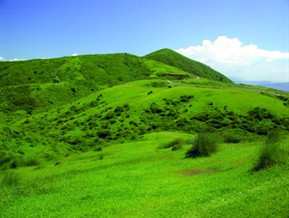
View of Mt. Zhugao From Taiyanggu
The steady growth of the global economy drives the robust development of the tourism industry. Nature-orientated tourism is experiencing an annual increase of 10% to 30%. It is estimated that there will be 1.6 billion tourists worldwide by 2020 (The International Ecotourism Society, 2000).The rapid growth brings economic benefits and also causes environmental impact. The World Commission on Environment and Development (WCED) and the International Union for Conservation of Nature and Natural Resources (IUCN) suggested the concepts of "sustainable tourism development" and Ecotourism, taking into account both environmental conservation and recreational use so that people, natural resources, and recreation use can achieve a positive balance for sustainable development. On July 30, 1998 the United Nations Economic and Social Commission held its forty-sixth General Assembly and designated the year 2002 as the "International Year of Ecotourism". The World Tourism Organization and United Nations Environment Programme jointly promoted ecotourism as a development strategy, with the goal of maintaining biodiversity and the hope of promoting global participation, review, and exchange. Through these exchanges we wish to construct an ecotourism model that allows tourism to promote economic prosperity while balancing environmental protection and expand ecotourism as a major international development trend.
The purpose of establishing a national park is to protect the unique natural landscape, native species, cultural and historical sites, as well as provide a place for leisure and research. The area was originally established as a protected habitat with the aim of conserving species and restoring the ecosystem. Balancing the recreational needs and preservation of the habitat has become increasingly important. Yangmingshan National Park, for example, has an average of approximately 12,900 visitors a day. Such a large number of tourists will surely impact the park’s natural and cultural resources. In response, the park’s headquarters has developed guidelines for selecting ecotourism routes and itineraries and educated the community on sustainability and ecotourism in order to cultivate positive attitudes towards the environment within the community so that tourism can evolve into environmentally responsible ecotourism.